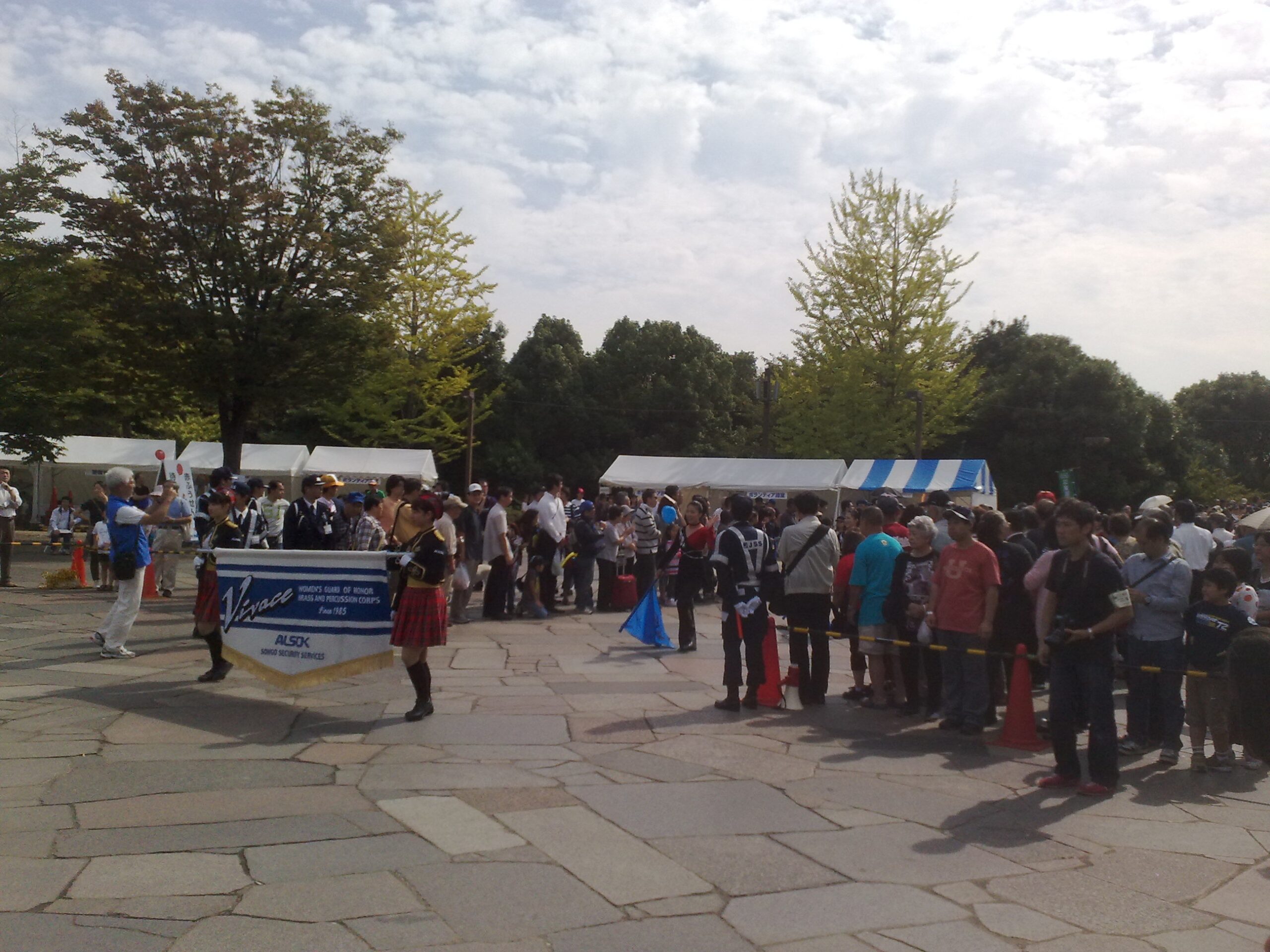日本文が後ろに続きます。
October is a month of fruits, readings, sports, art, and — more than those — festivals. There were various kinds of festivals in Kiba Park, which was close to my house. The biggest one was the Koto Kumin Matsuri festival from the 16th through the 17th of October.
10月は食欲の秋、読書の秋、スポーツの秋、芸術の秋といろいろありますが、なんといっても祭りの時期だと思います。近所にある木場公園では毎週いろんなイベントがありましたが、なかでも一番大きいのが10月16日〜17日の江東区民まつりでした。

It was the third time for me to see this festival, so there was nothing new in it. Everything was almost the same as usual. All I did there were to eat Indian foods bought from stalls inside the park and to watch a performance by Vivace, a marching band consisting of only female employees of ALSOK, a Japanese security company.
In the same days, there was a festival by the students of the University of the Sacred Heart, which had been built in the former residence of Empress Dowager Nagako, the previous Emperor Hirohito’s wife. This university is for women only, so it’s usually closed to people other than the students of it, except on special days like the festival. I wanted to get inside the university because I wanted to see the historical houses inside, such as the former house of Nagako and the chapel of the university. During the festival, the university was open to the public, so it was one of the perfect chances to see them, which wouldn’t come so many times.
After seeing the Koto Kumin Matsuri, I went to Hiroo to see the festival of the University of the Sacred Heart called Seishinsai. I took the subway to Shibuya and there I took a bus to Japan Red Cross Medical Center, where I got off the bus, and I had a gate of the university. After the ID check at the gate, I got inside and walked along the path for several minutes then I had the Palace, the former house of the Prince Kuninomiya, where his daughter Nagako had been raised and lived until she had married the previous Emperor Hirohito.
江東区民まつりを見るのも3回目なので特に目新しいものはありませんでしたが、屋台でインド料理を食べ、ALSOKの女子儀仗隊「Vivace」の演奏を楽しんできました。
ところで同じ日に、広尾の聖心女子大学で「聖心祭」という学園祭がありました。ここの大学は旧久邇宮家の邸宅の跡地に建てられていて、香淳皇后が昭和天皇とのご成婚までの間、ここに住まわれていた場所にあります。女子大なので当然、普段は一般人はシャットアウトなんですが、聖心祭の期間中は一般人にも開放されています。ということで、久邇宮邸やクニハウスなどの歴史的建造物を見てみたかったので、聖心祭期間は絶好のチャンスというわけです。
ということで、江東区民まつりのあと、広尾に行ってきました。渋谷から日赤医療センター行きのバスに乗り、終点で降りると、すぐに大学の門が見えてきます。入口でIDチェックをすませ、中の小径を数分歩くと、「パレス」とよばれる久邇宮邸がありました。香淳皇后がご成婚までここに住まわれていた場所です。

The Kuni House, the site of the main entrance of the Palace, where Empress Nagako departed to the Imperial Palace at her wedding.
クニハウス。久邇宮邸の正面玄関跡です。ご成婚に際して、ここから宮城へご出立あらせられました。

The Marian Hall, an auditorium of USH. The Latin phrase on the top made me feel it was gorgeous.
マリアンホール、講堂です。上のラテン語がゴージャス感いっぱいです。

The chapel, used daily for masses and prayers. An alumna of USH can use it for her wedding.
チャペル。ミサや礼拝など日常的に使われており、卒業生はここで結婚式をあげることもできます。

The interior of the chapel, where the student choir practised singing. I heard their sounds reflected in multiple directions on the round ceiling and resonated fantastically. I admired its gimmick of construction for helping Catholics feel God’s Power.
Besides, there was an open-air stage, stalls selling foods and goods, and many kinds of events and amusements during the festival, but I left in haste because there were such young and bright boys and girls that a middle-aged man like me couldn’t stay any longer 🙂
チャペル内部。学生の聖歌隊が練習してました。丸い天井で音が反響して神秘的に響くように工夫されてつくられているのに感心しました。
それ以外にも露天ステージやら模擬店やらその他もろもろお楽しみイベントがいっぱいでしたが、若くてまぶしい男女がいっぱいいて、オジサンとしてはいたたまれなくなったので早々に退散しました。。。



